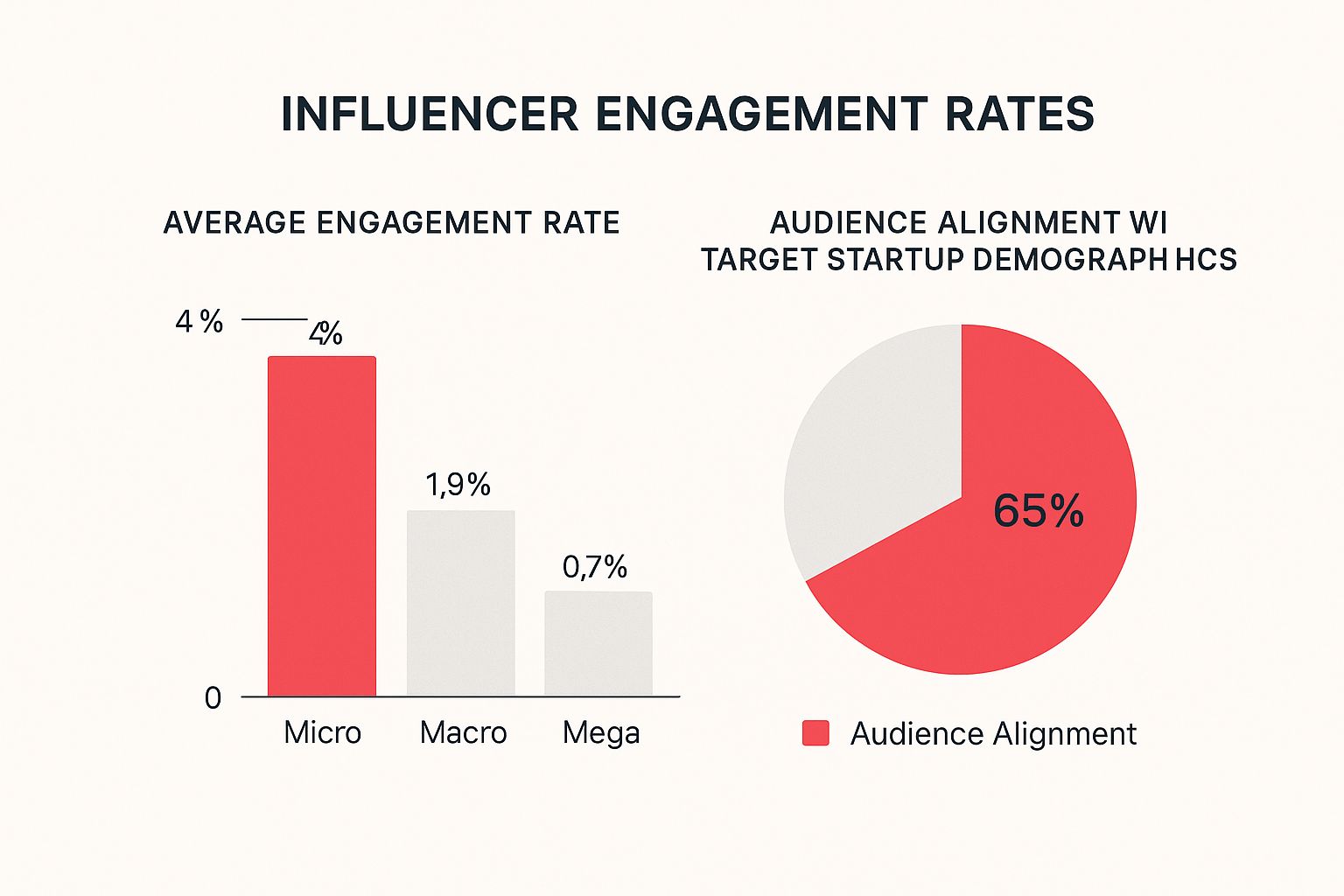 Why Authenticity Beats Perfection in Modern Marketing
Why Authenticity Beats Perfection in Modern Marketing
Table of Contents
Why Influencer Marketing Is Your Startup's Secret Weapon
For startups, getting noticed by potential customers can be a real challenge. Traditional marketing often requires big budgets, which many startups simply don't have. That's where influencer marketing comes in. By working with the right creators, startups can access existing audiences and build credibility quickly. This allows them to skip the long process of building an audience from the ground up and gain brand awareness rapidly.
Leveraging Authenticity and Building Trust
Big brands often rely on expensive ad campaigns, but startups can achieve similar results with authentic storytelling. Influencers have a distinct advantage: they've built trust and genuine relationships with their followers. A recommendation from a trusted influencer can be much more effective than a generic ad. This genuine approach really connects with audiences, building a sense of community around your brand. It's important to avoid common marketing missteps. Learn about some typical marketing mistakes startups make and how to avoid them.
Cost-Effective Reach and Targeted Engagement
Influencer marketing doesn't require huge budgets. Startups can achieve substantial reach by partnering with micro-influencers (those with smaller but highly engaged followings). This targeted approach helps you reach specific niche audiences, ensuring your message gets to the right people. Platforms like TikTok offer excellent engagement rates, especially for smaller accounts, making them perfect for startups looking for cost-effective campaigns. Influencer marketing has grown significantly, from a $1.7 billion industry in 2016 to a projected $24 billion by the end of 2024. This includes a 29% increase between 2022 and 2023, showing its resilience and increasing importance. Find more detailed statistics here.

Adapting Your Strategy for Growth
Influencer marketing isn't a one-size-fits-all approach; it changes as your startup does. Before launch, influencers can create buzz and build anticipation. As you grow, your strategy can shift to gaining customers and expanding your customer base. This flexibility allows startups to adjust their marketing to various growth stages, maximizing impact at each step. Whether it’s generating pre-launch excitement or driving conversions after launch, influencer marketing provides adaptable solutions for sustained growth. Product seeding with micro-influencers, for example, can create early adopters and gather valuable feedback before a full product release. Later, collaborations with larger influencers can expand reach and boost sales as your startup grows.
Finding Creator Partners Who Truly Move the Needle
Forget vanity metrics like follower counts. For startups, influencer marketing success hinges on finding creators who genuinely connect with your target audience and deliver tangible results. This means looking beyond superficial numbers and delving into engagement quality, audience alignment, and content authenticity.
Evaluating Influencers Beyond Follower Counts
How do you pinpoint influencers who truly align with your startup's objectives? Start by examining the quality of their engagement. Are their followers actively commenting, sharing, and participating in conversations? High engagement rates often signal a dedicated, loyal community—far more valuable than a large but disengaged following.
Also, evaluate how well the influencer's audience matches your target demographics. Do they have shared interests, values, and buying habits? A strong overlap boosts the probability of your message resonating and converting followers into customers.

The infographic above illustrates average engagement rates across micro, macro, and mega influencers, along with the percentage of audience alignment with typical startup target demographics. Notice how micro-influencers often exhibit higher engagement rates and better audience alignment, making them a potentially more effective and budget-friendly option for startups.
Finally, consider the genuineness of the influencer’s content. Does it feel authentic and relatable? Authenticity fosters trust, which is essential for driving conversions and cultivating long-term brand loyalty.
To help illustrate the selection process, let's look at some criteria startups should consider when choosing influencers. The table below offers a comparison of different influencer tiers and their benefits for startup marketing.
Influencer Selection Criteria for Startups
| Influencer Type | Typical Audience Size | Average Engagement Rate | Estimated Cost Range | Best For |
|---|---|---|---|---|
| Nano-influencer | 1,000 – 10,000 | 5% – 10% | $10 – $100 per post | Highly niche products, local businesses |
| Micro-influencer | 10,000 – 50,000 | 2% – 5% | $100 – $500 per post | Building brand awareness, targeted campaigns |
| Mid-tier influencer | 50,000 – 500,000 | 1% – 2% | $500 – $5,000 per post | Reaching a wider audience, driving sales |
| Macro-influencer | 500,000 – 1 million+ | <1% | $5,000+ per post | Large-scale campaigns, maximizing reach |
As this table shows, different tiers of influencers offer varying benefits and costs. Startups should weigh these factors carefully to choose the best fit for their specific needs and budget.
Efficient Research Methods for Startups
Discovering the right influencers can be time-intensive. However, several efficient research methods cater specifically to startup time limitations. Manual discovery methods, like searching relevant hashtags and examining competitor collaborations, offer valuable insights. For example, a fitness apparel startup searching hashtags like #fitnessmotivation or #gymlife might uncover relevant micro-influencers already engaging with their target audience.
Furthermore, several affordable platform solutions, such as JoinBrands, simplify the influencer discovery process. These platforms provide refined filtering options, enabling quick identification of creators based on niche, engagement, and audience demographics. This saves time and resources, allowing you to concentrate on forging impactful collaborations.
Outreach and Avoiding Partnership Mistakes
Once you've located potential partners, strong outreach is vital. Personalized messages demonstrating genuine interest in the influencer’s work and audience are more apt to receive a positive response. Referencing a specific piece of content shows you’ve done your research and aren't sending a generic template.
Be mindful of warning signs, though. Inflated engagement metrics, a lack of transparency, or a history of inauthentic partnerships are red flags that could signal a costly misstep. By carefully assessing potential partners and crafting personalized outreach, startups can cultivate successful influencer collaborations that yield genuine business results.
Maximizing ROI When Every Marketing Dollar Counts

For startups, maximizing return on investment (ROI) is crucial. Every marketing dollar needs to fuel growth, making strategic influencer marketing essential. This section explores how startups can structure influencer collaborations that deliver tangible results without overspending. We'll delve into creative compensation models that align creator incentives with your startup’s objectives.
Creative Compensation: Beyond Cash Payments
Traditional influencer marketing often involves significant upfront payments. However, startups with limited budgets can explore alternative compensation structures. These models minimize initial costs while keeping creators motivated.
One approach is product-for-post, where influencers receive free products in exchange for creating content. This is particularly effective for product-focused businesses.
Another strategy is performance-based compensation. This links influencer payments directly to results, such as website clicks, leads, or sales. This encourages creators to actively promote your brand while minimizing startup risk. It's similar to a commissioned salesperson, where payment depends on closed deals.
Consider offering equity or profit sharing to long-term influencer partners. This can secure consistent, high-quality promotion while conserving cash flow. To present your brand effectively, create a comprehensive media kit. Check out these influencer media kit examples for inspiration.
Tracking Performance and Demonstrating ROI
Showing the impact of influencer marketing is vital, especially for attracting investors. Practical tracking provides the necessary data.
Begin by defining clear campaign goals. Are you focused on brand awareness, website traffic, or sales? This clarity guides your tracking process. Use unique tracking links with UTM parameters for each influencer to pinpoint which creators drive the most valuable traffic.
For e-commerce startups, exclusive discount codes tied to specific influencers effectively track conversions directly attributed to each partnership.
The cost-effectiveness and flexible monetization of influencer marketing make it ideal for startups. In 2025, the average cost per thousand impressions (CPM) decreased by 53% year-over-year, indicating increasing affordability for smaller brands. More detailed statistics are available here. While 57% of creators increased their rates in 2025, 83% remain open to product-for-post collaborations.
Negotiation Frameworks for Startups
Startups may lack the negotiating power of larger companies. However, several tactics can help secure favorable agreements with influencers.
Emphasize your startup's unique value proposition. This could be the chance to join an exciting new venture or reach a highly engaged niche audience. Clearly communicate the mutual benefits of the partnership, focusing on the value exchange for the influencer. This win-win approach facilitates productive negotiations.
Be flexible and explore alternative partnership structures. A smaller upfront payment combined with performance bonuses can be a mutually beneficial solution. This allows for experimentation and scaling while minimizing financial risk. By implementing these strategies, startups can forge strong influencer relationships that drive growth and conserve valuable resources.
Building Creator Relationships That Grow With Your Startup
Going beyond single influencer posts is crucial for any startup looking for long-term growth. Smart founders know that nurturing ongoing creator relationships offers much better results over time. These relationships become woven into the brand’s identity and overall marketing approach. Let's explore how to develop these valuable, lasting partnerships.
From Transactions to Authentic Partnerships
Startups can shift from one-time influencer campaigns to genuine brand ambassadors. It all starts with finding creators who truly align with your company's values. These shared values create a powerful synergy, leading to content that feels authentic and engaging.
Mutual benefit is another essential piece of the puzzle. When both the startup and the influencer gain from the partnership, it creates a much stronger, more sustainable bond. This could involve sharing resources, collaborating on marketing strategies, or simply supporting each other's growth.
For example, imagine a sustainable clothing startup partnering with an influencer who is passionate about ethical fashion. This shared value allows for authentic storytelling that truly resonates with the target audience and helps build a loyal community around the brand.
Evolving Partnerships Throughout Your Startup Journey
As your startup grows, so too should your influencer relationships. Initially, these partnerships might focus on building brand awareness and reaching new potential customers. As your startup expands, the focus might shift towards more structured ambassador programs.
This evolution could involve co-creating product lines or engaging in joint marketing ventures. Adaptability is key, ensuring the partnership remains beneficial for both parties as the startup evolves.
By 2025, influencer marketing is predicted to be a $32.55 billion market, with over 80% of marketers recognizing its effectiveness. This underscores the importance of influencer marketing for startup growth. Learn more about these trends. Interestingly, 47% of marketers are already prioritizing long-term influencer relationships, highlighting the growing importance of building trust and community through sustained partnerships.
Practical Frameworks for Growing Companies
Managing these evolving relationships requires well-defined frameworks. This includes practical contract templates outlining the terms of the partnership, including compensation, content guidelines, and intellectual property rights. Efficient relationship management ensures smooth communication and collaboration.
Regular check-ins, feedback sessions, and open dialogue strengthen the partnership and help address any potential roadblocks proactively. Clear measurement frameworks are also vital. Tracking key metrics such as engagement, reach, website traffic, and conversions helps demonstrate the value of these collaborations and informs future campaigns.
Adapting to Change and Growth
As your startup secures funding, enters new markets, or adjusts its business model, influencer partnerships need to adapt as well. This might involve renegotiating contracts, tweaking content strategies, or bringing in new influencers who better align with your evolving target audience.
This flexibility ensures influencer marketing stays effective and aligned with your overall business goals, even as your startup undergoes significant changes. By fostering genuine relationships and adapting to change, startups can successfully use influencer marketing for sustainable growth and lasting success.
Creating Content That Resonates Without Feeling Forced
Authenticity is the key to successful influencer marketing. It's what separates memorable campaigns from those that quickly fade away. This section explores how startups can collaborate with influencers to develop content that truly connects with audiences while achieving business objectives.

The Art of the Creator Brief
Effective influencer marketing starts with a creator brief. This document provides influencers with essential information and guidance, without restricting their creativity. A good brief outlines campaign goals, the target audience, key messages, and preferred content formats. Crucially, it also allows room for the influencer's unique perspective. Think of it as providing the tools, but letting the artist create the masterpiece.
Balancing Brand Messaging and Authentic Voice
Finding the sweet spot between brand messaging and an influencer's authentic voice is crucial. Too much brand control makes content feel forced. Too little, and the message gets lost. The key is collaboration. Work with the influencer to adapt your message to their style. Instead of rigid scripts, suggest themes and talking points. Let the influencer interpret them authentically. This strengthens the partnership and creates more impactful content.
Common Content Pitfalls and How to Avoid Them
Several common mistakes can undermine authenticity. Overly scripted content often feels unnatural. Inconsistent brand alignment can damage credibility. Ignoring audience feedback is a missed opportunity. Monitor comments and engagement, and adjust your strategy as needed.
Streamlining Approval Workflows for Lean Startup Teams
Efficient approvals are essential, especially for resource-strapped startups. Set clear expectations from the start. Designate a single point of contact. And use online collaboration tools to streamline the process. Platforms like JoinBrands offer features designed to simplify these workflows, speeding up content creation and campaign execution.
Leveraging User-Generated Content for Extended Impact
User-generated content (UGC) amplifies influencer campaigns. Encourage influencers to engage with their audience, inviting comments, questions, and content submissions. Sharing UGC on your brand's social media broadens reach and reinforces authenticity, building a community and fostering deeper connections with potential customers.
Maximizing Engagement Beyond Initial Posts
Influencer marketing isn't a one-and-done deal. Encourage continued engagement by responding to comments, holding Q&A sessions, and creating follow-up content. This sustained interaction maximizes the value of influencer partnerships and builds stronger relationships with influencers and their followers.
To illustrate how different platforms perform, let's look at the following table:
Content Performance by Platform for Startup Campaigns
| Platform | Best-Performing Content Types | Average Engagement Rate | Conversion Potential | Resource Requirements |
|---|---|---|---|---|
| Reels, Stories, Carousels | 1-3% | Medium | Medium | |
| TikTok | Short-form videos, Live streams | 2-5% | High | Low |
| YouTube | Longer-form videos, Reviews | 1-2% | Medium | High |
This table shows the importance of tailoring content to each platform. By understanding these nuances and using the right formats, startups can improve campaign performance and maximize their return on investment.
Measuring What Matters: Analytics That Drive Decisions
For startups, making the most of every marketing dollar is critical. Knowing what strategies are effective and which ones aren't is essential for growth. This section provides practical frameworks for tracking, analyzing, and optimizing influencer campaigns without needing complex enterprise software. We'll explore key metrics, accessible attribution methods, and how to transform performance insights into smarter decisions.
Identifying Key Metrics for Startup Success
Different business objectives require different metrics. There's no one-size-fits-all approach. For early-stage brand building, focus on reach, impressions, and engagement (likes, comments, shares). These metrics reveal how many people your campaign is reaching and how they interact with your content. Tracking hashtag usage, for example, can show how organically your message is spreading.
If direct sales are your goal, prioritize website clicks, conversions, and revenue generated. These metrics directly connect influencer efforts to your bottom line, offering concrete evidence of campaign ROI.
Accessible Attribution for Clear Tracking
Understanding which influencer drove a specific sale is crucial for optimizing your budget. Thankfully, several accessible methods make this possible. UTM parameters, added to unique tracking links for each influencer, allow for precise measurement of website traffic sources.
Discount codes tied to individual influencers help track conversions and revenue linked to each partnership. If the code "INFLUENCER10" generates more sales than "INFLUENCER20," you have clear direction on where to invest further. Creating custom landing pages for each influencer provides a focused user experience and simplifies conversion tracking. These approaches offer valuable data without requiring extensive technical resources.
Benchmarking Performance and Showing Progress
Comparing your campaign results against industry benchmarks and your own historical data provides valuable context and demonstrates growth. Industry averages for engagement rates and conversion rates serve as useful benchmarks. If your campaign's engagement rate is significantly higher than the industry average, it's a good indication that your strategy is working.
Tracking your own campaign performance over time reveals important trends and progress. This data is invaluable for internal analysis and for demonstrating growth to stakeholders and potential investors. It clearly shows that your influencer marketing strategy is generating tangible results.
Connecting Metrics to Broader Business Goals
Influencer marketing metrics shouldn't exist in a vacuum. It's important to connect them to broader business outcomes to understand their true impact. How does increased brand awareness translate into lead generation or affect customer acquisition cost? By connecting these dots, you can demonstrate the strategic value of influencer marketing and justify continued investment.
Using performance insights to refine future campaigns is essential for ongoing success. Analyze what worked well and what didn't. Did certain content formats resonate more effectively? Did specific influencers drive more conversions? Use these insights to make data-driven decisions about future campaign investments and maximize your ROI. Continuously analyzing, adapting, and optimizing your influencer marketing strategy based on data will ensure maximum impact and drive sustainable growth for your startup. Ready to take your influencer marketing to the next level? JoinBrands provides the tools and resources you need to manage campaigns, track results, and achieve measurable growth. Visit JoinBrands today to learn more.








